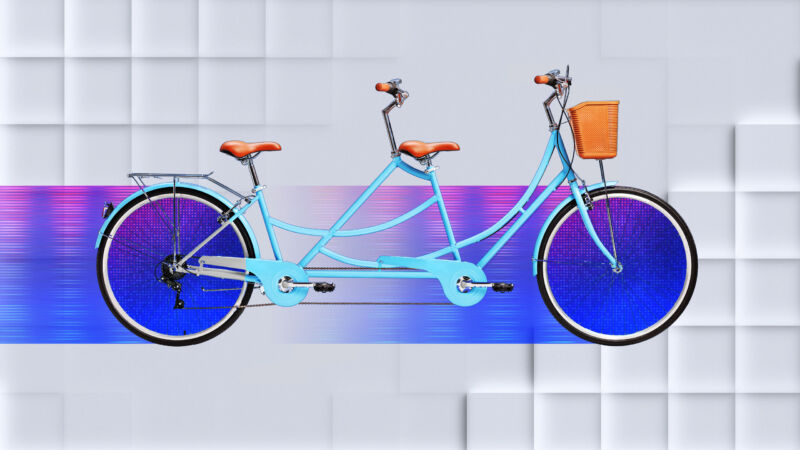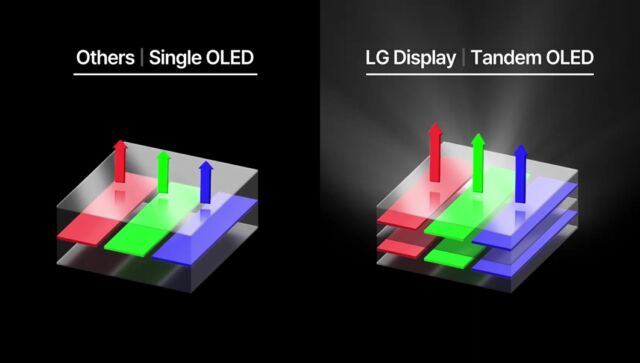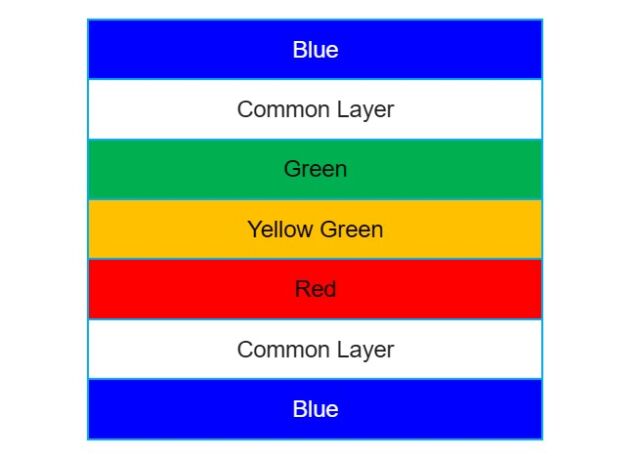
Aurich Lawson | Getty Images
Tandem OLED has been around for years, but Apple made the technology feel new and shiny when it announced that the screen in its first ever OLED-based iPad would use a tandem structure.
Other consumer gadgets, like laptops and phones, are also slowly starting to incorporate Tandem OLED displays. So we thought it’s a good time to look at how Tandem OLED is used, what benefits it’s delivering, and how the technology could impact future devices and compete against other emerging display technologies, like MicroLED and QDEL.
OLED TVs, monitors already use different kinds of tandem stacks
We won’t go too deep into the technical details of Tandem OLED in this article (interested readers can reference this handy breakdown, which also includes information on current technical obstacles, like light-extraction inefficiencies). But if you’re new to Tandem OLED, here’s a brief look at what makes it so interesting for tech gadgets.
Simply put, Tandem OLED screens, like the one on the M4 iPad Pro, have two layers of red, green, and blue (RGB) organic light-emitting layers stacked atop one another and are driven in tandem. Because of those two layers, a Tandem OLED screen can reach the same brightness levels as an identical design with one OLED stack but with each layer in the display running at lower currents than in a single-stack OLED. The primary benefits are less burn-in risk, less power consumption, and the potential for higher brightness levels.

LG Display
In this article, we’ll use the term “Tandem OLED” to refer to displays that use two layers of RGB OLED materials. This is the setup that has received recent attention in consumer displays thanks to devices like the iPad Pro and XPS 13. But other OLED displays use different kinds of tandem structures. OLED TVs and monitors using LG Display’s WOLED (white OLED) and Samsung Display’s QD-OLED (quantum dot OLED) also use tandem stacks.

Ross Young
QD-OLED screens even use three stacks of blue OLED emitter layers (reportedly to manage the inefficiency of blue emitters).
As Ross Young, CEO at Display Supply Chain Consultants (DSCC), told me via email, “WOLED uses two blue layers with red and green in a stack, and QD-OLED uses three blue layers and green in a stack. These panels are creating white (WOLED) and blue (QD-OLED) light only, so it is different than the RGB tandem stacks being used for the OLED iPad Pros and select automotive displays.”
With modern OLED TVs already getting a lot of brightness from their current multi-stack OLED architectures, there may be minimal incentive for Tandem RGB OLED stacks to hit high-end TVs, Eric Virey, principal displays analyst at Yole Intelligence, told me. He also noted complications in the manufacturing process:
In addition, the manufacturing process used in TV manufacturing is different from the one used in smaller OLED devices and wouldn’t be compatible with RGB Tandem OLED. To be more specific, small OLED displays, such as smartphones, tablets, smartwatches, and laptops, are made using a Fine Metal Mask (FMM) patterning technology, whereas large OLEDs, such as TVs, use an open mask. The latter wouldn’t fly with an RGB Tandem OLED architecture.

